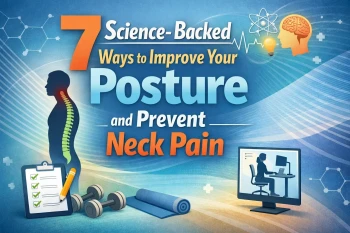
Our bodies are wired with built-in defense systems—automatic responses designed to protect us without conscious thought. One of the most fascinating examples of this is spinal reflex control.
Reflexes are those split-second reactions, like pulling your hand away from a hot stove or blinking when dust gets too close to your eyes. They happen so quickly because the body doesn’t always wait for the brain to decide what to do; instead, the spinal cord takes the lead.
That quick processing is possible thanks to something called the reflex arc—a nerve pathway that allows information to be sensed, transmitted, and acted on in an instant.
While reflexes may seem simple, their presence, strength, and accuracy are actually important indicators of nervous system health. When spinal reflex control is abnormal, it’s often a red flag that deeper issues may be present in the spinal cord, brain, or nervous system.
How the Reflex Arc Works
A reflex is more than just a knee-jerk reaction—it’s an orchestrated process involving several steps:
1. Stimulus – Something triggers the response (heat, cold, pressure, etc.).
2. Receptor – Specialized nerve endings detect the stimulus and send a signal.
3. Sensory Neuron – Carries the signal toward the spinal cord.
4. Interneuron – Connects sensory input to motor output inside the spinal cord.
4. Motor Neuron – Sends instructions outward from the spinal cord.
5. Effector – A muscle or gland responds, producing the action (like pulling your hand back).
Because the spinal cord handles the processing directly, reflexes are fast—often faster than conscious thought. This speed helps protect the body from injury and helps maintain balance, posture, and stability without us having to think about it.
What Abnormal Reflexes Can Reveal
Normal spinal reflexes indicate that the nervous system is firing properly. But when reflexes are absent, exaggerated, or persist when they shouldn’t, it can point to problems in the spinal cord, brain, or peripheral nerves.
Doctors and chiropractors often test reflexes to assess nervous system health. Here are some of the most recognized abnormal reflex responses:
- Glabellar Reflex (Myerson’s Sign): Tapping between the eyebrows usually triggers a blink, but repeated taps should cause the blinking to stop. If it continues, it can be a sign of a neurological issue such as Parkinson’s disease.
- Clonus Reflex: When the foot is flexed, a normal response is one or two twitches. If instead, the foot repeatedly spasms in rapid succession, this suggests an upper motor neuron disorder or spinal cord injury.
- Snout Reflex: In infants, tapping near the lips can trigger a pursing or pouting response. This fades with age. When seen in adults, however, it can indicate a frontal lobe problem caused by trauma or stroke.
- Babinski Reflex: Scratching the sole of the foot normally causes the toes to curl downward in adults. If instead the toes fan out and extend upward, it may signal meningitis, a stroke, or spinal cord damage.
- Hoffman’s Reflex: Flicking the middle or ring finger may cause the thumb to twitch. While minor twitches can be normal, a strong or uneven response often points to spinal cord compression or neurological disorder.
These reflex tests are simple, but their implications can be serious. They reveal whether the body’s natural wiring is intact—or if there’s interference disrupting communication between the brain, spinal cord, and muscles.
The Spinal Cord’s Role in Reflex Control
Your spinal cord is more than just a highway for signals traveling to and from the brain. It also manages reflexes independently through the reflex arc.
But when the spine is not aligned correctly—particularly at the top two vertebrae, known as the atlas and axis—that delicate communication can be disrupted.
Even small misalignments at the upper cervical spine can twist or strain the spinal cord, affect brain stem function, and change how reflexes present. Abnormal reflexes aren’t just random quirks; they’re the body’s way of signaling that communication lines are compromised.
How Upper Cervical Chiropractic Helps Restore Balance
Upper cervical chiropractic care focuses on the atlas (C1) and axis (C2)—the top two vertebrae just beneath the skull. These bones protect the brain stem, a vital control center where messages from the brain are sent to the rest of the body.
When either bone shifts out of alignment, it can set off a domino effect:
- The head tilts.
- The body compensates by twisting, turning, or curving the spine to keep the head level.
- Muscles tighten, tissues weaken, and the spinal cord may be pulled or compressed.
- Nervous system function—including reflex control—can become impaired.
By correcting these misalignments, upper cervical chiropractors remove unnecessary pressure from the brain stem and spinal cord. This allows normal communication to resume between the brain and body.
Unlike traditional chiropractic adjustments, upper cervical corrections are gentle, precise, and customized to the individual. They don’t involve twisting or cracking the neck. Instead, imaging and neurological testing guide a light correction that restores balance.
Why This Matters for Reflexes
When the nervous system is clear of interference, reflexes often normalize. Patients report that not only do their reflex responses improve, but other issues tied to nervous system dysfunction also start to change—things like muscle weakness, coordination problems, even headaches or chronic pain.
A healthy brain stem means better communication, stronger reflexes, and improved healing throughout the body. Once the nervous system is functioning properly, muscles and tissues around the spine are able to recover and stabilize as well.
It’s not uncommon for patients to notice changes after just one or two upper cervical adjustments—sometimes in ways they didn’t even expect. Because this type of care works at the level of the body’s master control system, improvements often ripple outward into many areas of health.
Natural Healing Starts with the Nervous System
Spinal reflex control is more than a neurological curiosity—it’s a vital part of how your body protects itself and maintains balance. When reflexes are abnormal, it’s a clue that the nervous system may not be functioning as it should.
Upper cervical chiropractic offers a natural, non-invasive way to correct spinal misalignments that interfere with reflex control. By focusing on the atlas and axis, this specialized form of care restores communication between the brain, spinal cord, and body—helping reflexes return to normal and supporting the body’s ability to heal itself.
If you or someone you love has been told they have abnormal reflexes, or if you suspect your nervous system isn’t firing on all cylinders, it may be worth exploring whether upper cervical care could be the missing piece.
Your body is designed to respond, adapt, and protect itself. Sometimes it just needs a little help clearing the interference so those systems can work the way they’re meant to.







Leave a comment